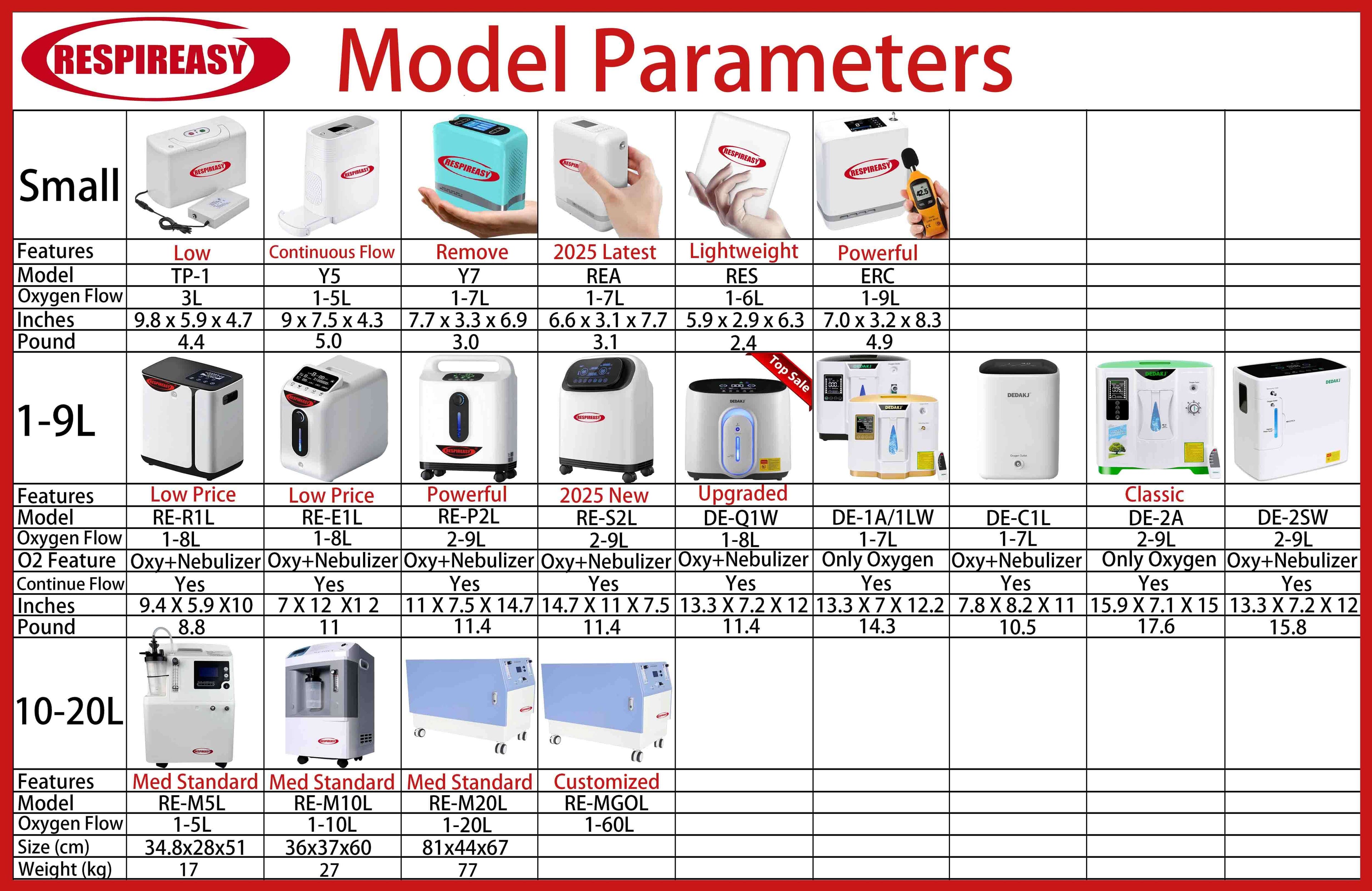How to Choose a Home Oxygen Concentrator
Share

Oxygen therapy is one of the most direct and effective treatments for hypoxic diseases. Long-term home oxygen therapy can correct hypoxemia, reduce damage to vital organs such as the heart, brain, kidneys, and lungs, and improve patients' quality of life. The key to home oxygen therapy is scientific guidance on oxygen use and a medical-grade oxygen concentrator.
1. Home Oxygen Concentrator Purchase Guide
-
Oxygen Concentrator Specifications (Liters) Definition
An X-liter oxygen concentrator refers to one that maintains an oxygen concentration of 93% ± 3% at its maximum output of X liters. If X ≥ 3, it can be used for medical purposes and is called a medical oxygen concentrator (with a medical device registration certificate); otherwise, it is a health care oxygen concentrator. The maximum capacity of an oxygen concentrator is backward compatible.
-
Suitable Users for Different Sizes of Oxygen Concentrators
1L oxygen concentrators are commonly used for health maintenance, such as pregnant women, students, and office workers who use their brains for extended periods, to enhance immunity and other health benefits.
3L oxygen concentrators are commonly used for elderly health maintenance, and for those with hypertension, cardiovascular and cerebrovascular hypoxic diseases, hyperglycemia, and obesity.
5L oxygen concentrators are commonly used for cardiopulmonary diseases (COPD, pulmonary heart disease).
8L oxygen concentrators are commonly used for special patients requiring high oxygen flow rates and long-term oxygen therapy.
Oxygen Concentrator Working Principle
Utilizing air separation technology, air is first compressed at high density. Then, the different molecular sizes of the air components are used to separate them through molecular sieve adsorption. This separates the air into oxygen and nitrogen, and then further separates the nitrogen from the oxygen, ultimately obtaining a high concentration of oxygen.
The compressor and molecular sieve are the core components of an oxygen concentrator. A more powerful compressor and a finer molecular sieve are fundamental to improving oxygen production capacity, which is roughly reflected in the size of the oxygen concentrator, the materials of its components, and its manufacturing technology.



-
Oxygen Inhalation Tools
Nasal cannula oxygen therapy is divided into single-sided and double-sided nasal cannulas, as well as nasal plugs. If using nasal plugs or a nasal cannula, breathe through your mouth. Double-sided nasal cannulas are generally preferred, as long-term use of a single-sided nasal cannula can cause significant irritation to the nasopharynx. Nasal plugs placed in the anterior nostrils are more comfortable and convenient, but are prone to falling out. Face masks interfere with speaking and eating and compress the face, so they should only be used for short periods.
-
Supporting Equipment
Oxygen concentrators can address the issue of inhaled oxygen concentration, but not the inhalation itself. When respiratory distress or sleep apnea syndrome occurs due to carbon dioxide retention, a non-invasive ventilator can be used in conjunction. Sleep apnea syndrome requires only a constant-pressure single-level ventilator, while lung diseases require a bilevel ventilator with two pressures. Based on the criteria for assessing hypoxemia, a pulse oximeter can be installed at home to quickly assess blood oxygen saturation and understand the body's condition while using oxygen.

-
Key Points for Purchasing an Oxygen Concentrator
① If the budget allows, choose an oxygen concentrator with oxygen concentration monitoring capabilities. ② Choose an oxygen concentrator with a sufficiently large compressor displacement. Larger compressors generally have a longer lifespan, meaning the machine itself should be larger.
③ For continuous oxygen therapy, a good heat dissipation system is necessary to ensure 24/7 or even 365-day continuous operation.
④ Higher compressor power results in increased noise. Industry standards stipulate that the noise level of an oxygen concentrator should be ≤60dB, with 45dB or below being considered comfortable.
⑤ Prioritize oxygen concentrators with large screen displays and voice prompts to reduce ease of use.
⑥ Patients whose oxygen inhalation location is not fixed should also consider portability.
⑦ Choose an oxygen concentrator with a flow rate at or above the maximum required flow rate (in liters) based on your individual needs.
⑧ For use at high altitudes, choose an oxygen concentrator with an even higher flow rate (in liters).

2. Clinical Parameters of Home Oxygen Concentrators
-
Diagnosis of Hypoxemia
Normal arterial oxygen partial pressure (mmHg) is 102 ± (0.33 × age in years). Hypoxemia is generally defined as an arterial oxygen partial pressure below 80 mmHg, requiring oxygen therapy. When blood gas analysis to measure oxygen partial pressure is not possible in a hospital, a preliminary assessment can be made based on oxygen saturation. Oxygen saturation below 90% necessitates long-term home oxygen therapy; below 91%-95%, long-term home oxygen therapy is recommended.
-
Calculation of Oxygen Therapy Parameters
Generally, when using a nasal cannula for oxygen inhalation, it is open-type oxygen therapy, meaning the actual inhalation is a mixture of the oxygen concentrator's output and ambient air. If an oxygen concentrator provides X liters of oxygen per minute at a concentration M (M is between 0 and 1), and the body's inhalation volume is Y (varying from person to person), and the oxygen concentration in the air is 0.21, the inhaled oxygen volume is: X*M + (Y-X)*0.21 = 0.21*Y + (M-0.21)*X, and the oxygen concentration is 0.21 + (M-0.21)*X/Y. When inhaling 100% oxygen, it can be roughly estimated as 0.21 + 0.04*X.
-
Oxygen Therapy for Various Diseases
① Oxygen Therapy in the Stable Phase of Chronic Obstructive Pulmonary Disease (COPD)
For COPD patients with an arterial oxygen partial pressure below 55 mmHg or an arterial oxygen saturation below 88%, or those experiencing hypoxemia at night or during exercise, long-term oxygen therapy of more than 15 hours, including sleep time, is recommended. However, home oxygen therapy is not suitable when the condition is unstable. COPD oxygen therapy recommends low-flow oxygen therapy, with a flow rate of 0.5–3 liters/minute and an oxygen concentration of <35%, adjusted according to the doctor's guidance.
② Oxygen therapy for cardiovascular diseases
To prevent irreversible damage to the heart and brain due to hypoxia, supplemental oxygen during the early stages or at the onset of various cardiovascular diseases can effectively prevent complications.
③ Oxygen therapy for cerebrovascular diseases
Its role in emergency situations is similar to that for cardiovascular diseases.
The treatment principle for cerebral ischemia is to dilate blood vessels and increase tissue oxygen supply. Those with access to supplemental oxygen should receive additional oxygen at a flow rate of 2 liters/minute until symptoms are relieved, accelerating the correction of hypoxia. Increased blood oxygen concentration can also reduce blood viscosity and dissolve microthrombi. Starting from the day after onset, administer oxygen 1–2 times daily for 1–2 hours each time for 2–3 weeks to prevent recurrence.
Cerebral infarction is characterized by ischemia and hypoxia in the infarcted brain tissue. Appropriate oxygen therapy can increase blood oxygen concentration, reduce blood viscosity, and thus reduce brain tissue damage. For patients with acute cerebral infarction, the oxygen flow rate is usually 4 liters/minute. During the recovery period, patients can receive oxygen therapy at home for 1-2 hours each time, for two consecutive weeks, which can achieve good recovery results.
Patients with vertigo can also receive appropriate oxygen therapy. Increasing blood oxygen partial pressure and blood oxygen content helps alleviate inner ear hypoxia and gradually relieve symptoms. Oxygen therapy at home can be done once a day for 1-2 hours each time, with a flow rate of 1-2 liters/minute.
④ Oxygen Therapy for Diabetes
Oxygen therapy for diabetic patients can promote vigorous aerobic metabolism, increase glucose consumption and lower blood sugar, and simultaneously increase the production of adenosine triphosphate (ATP), which can promote the recovery of pancreatic function. Diabetic patients have highly oxygen-saturated hemoglobin, leading to a decrease in dissolved oxygen and causing a certain degree of tissue hypoxia. Oxygen therapy can increase dissolved oxygen. Patients with mild diabetes and no obvious symptoms do not need oxygen therapy. Patients with moderate diabetes can receive oxygen at a flow rate of 4-6 liters/minute, once daily for 2 hours, for 3-4 weeks, which generally yields good results. Severely ill patients should receive treatment in the hospital as prescribed by their doctor, increasing the frequency of oxygen therapy.
⑤ Oxygen therapy for cervical spondylosis
Cervical spondylosis accompanied by vertebral artery obstruction causing cerebral hypoxia can be improved with oxygen therapy.
⑥ Oxygen therapy for pregnant women and fetal distress
Fetal distress refers to fetal hypoxia in the womb, which can be improved with oxygen therapy.
⑦ Oxygen therapy for cerebral hemorrhage
Those with access to oxygen can receive 3-5 liters/minute, which can moderately alleviate cerebral hypoxia.
⑧ Oxygen therapy for acute myocardial infarction
Those with access to oxygen can receive 3-5 liters/minute, which can moderately alleviate myocardial cell apoptosis caused by hypoxia.
9. Oxygen Therapy for Asthma Attacks
Those with the means can inhale oxygen at a rate of 3 liters per minute to relieve hypoxia symptoms.
Note:
Risks and side effects of oxygen therapy: Inappropriate oxygen therapy may cause respiratory dryness, respiratory depression, oxygen toxicity, etc. Therefore, it must be carried out under the guidance of a professional doctor. The timing of oxygen inhalation, the flow rate of oxygen, and the humidification of oxygen should be carefully considered to ensure the safety and effectiveness of the treatment.
Summary
Home oxygen concentrators are important devices in modern healthcare. Their selection, use, and maintenance require a scientific and rigorous approach. By selecting appropriate equipment, combined with individual health conditions and doctor's advice, the quality of life for patients with hypoxic diseases can be significantly improved, and the occurrence of complications can be reduced. At the same time, understanding the working principle, clinical parameters, and compatible equipment of oxygen concentrators can better maximize their therapeutic effects. However, oxygen therapy should not be performed arbitrarily. It must be carried out under professional guidance, with reasonable control of oxygen inhalation time, flow rate, and concentration to avoid potential risks and side effects. In short, scientific use of oxygen and a healthy life are principles that every patient requiring home oxygen therapy and their family should follow.









